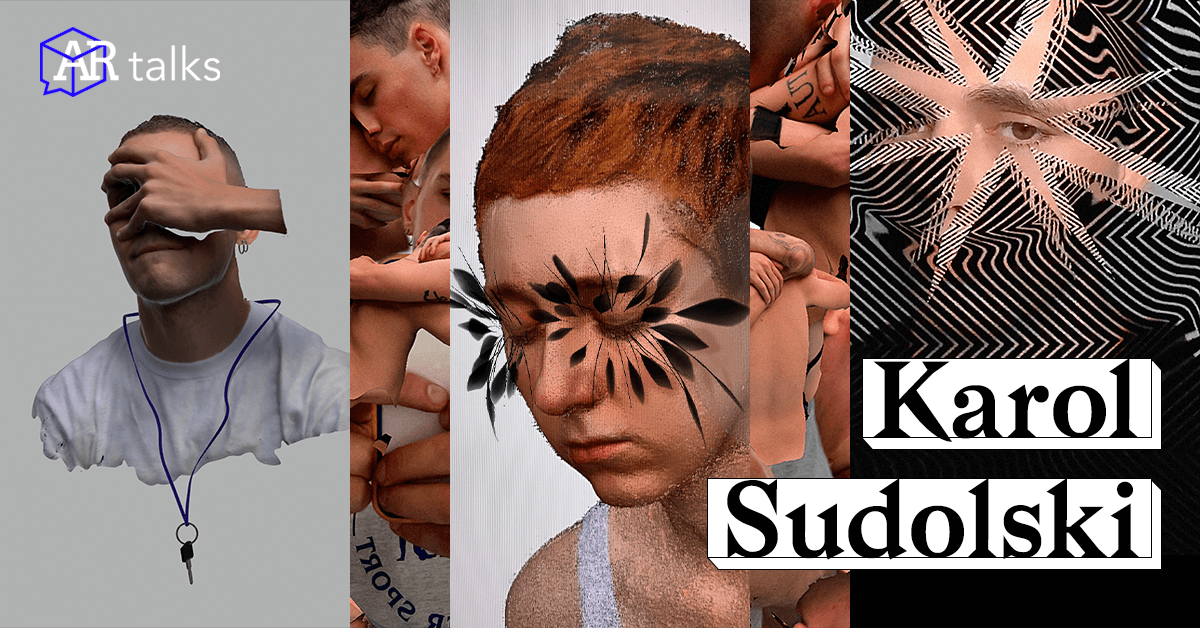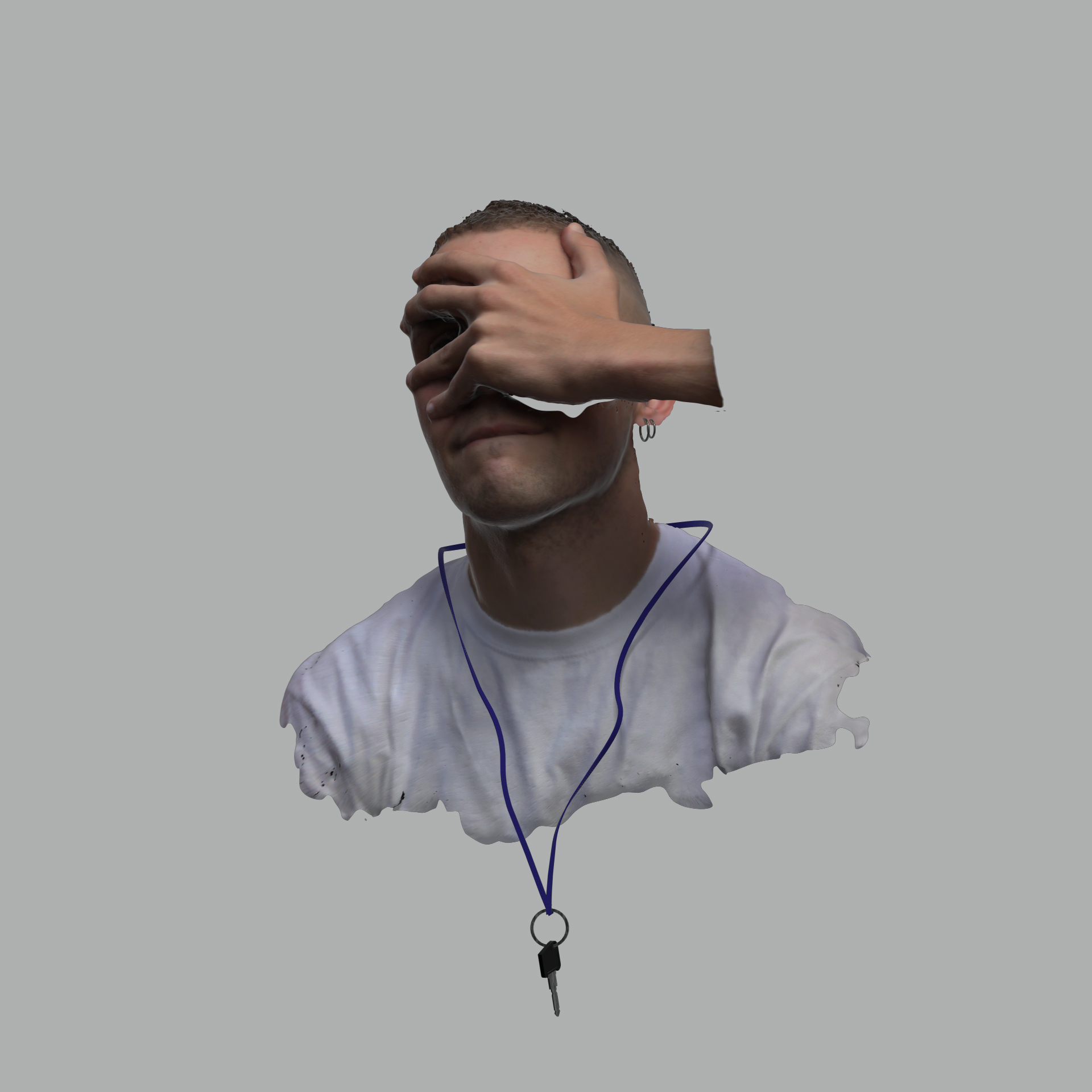AR Talk | Karol Sudolski

An artist by “accident”, driven by chance and randomness straight into the world of art – let’s welcome Karol Sudolski, a Milan-based visual artist and our today’s honorable AR Talk guest. ✨🫧💿His thought-provoking works are centered around feelings, humans and what’s not necessarily perfect about them. Today Karol shares with us his story – how it all began, what inspired him then, what he focuses on now and what’s his take on Augmented Reality, digital art, different techniques and more. 📸⭐️
⭐️⭐️⭐️
How did your journey as an artist start? I know it wasn’t planned – Is it true you are calling yourself an “accidental artist”?
 ‘Accidental artist’ sounds so good. It also manages people’s expectations of me, which makes me feel more comfortable.
‘Accidental artist’ sounds so good. It also manages people’s expectations of me, which makes me feel more comfortable.
I don’t have a background in Art and I am very unaware of the history and state of Contemporary Art. Finally, I do not know exactly what I am communicating, because being understood by an audience is not on my mind when I work on a project. For all these reasons, I cannot identify with being an artist.
My path has been more technically creative than artistic. My imagination developed from watching video clips and anime, and playing video games.
What interested me was never the technique or the story told, but more the world, the feeling, the emotional ‘scenography’ that these products managed to generate in me.
There was no precise beginning to my “journey as an artist”, just a lot of accidents.
I studied communication design, specifically editorial design. At the time, I was mainly interested in analogue photography and collages. I started working as a “jack of all trades” in fashion communication agencies in Milan, learning almost everything by myself, and making a lot of gifs. I discovered projectors and the scenographic dimension of videos by collaborating with the studio camerAnebbia. Then I met Liam Gallotti who gave me my first chance to do something with music. I created my first video clips and live visuals for his L I M project. Liam was also my first human subject for a 3d scan.
When looking through your artistic output, it’s hard to ignore your interest in photogrammetry. Can you tell us more about it? What do you find so appealing about this technique?
 I started scanning by chance and necessity, to solve a problem with a lack of assets for a video project.
I started scanning by chance and necessity, to solve a problem with a lack of assets for a video project.
What fascinates me most about photogrammetry is the way it manages to replicate human skin, with its light and shadows. Faces and bodies are always my favourite subjects.
My process of taking the photographs needed for the scan is neither orthodox nor professional. It is the amateur way pushed to the pro edge. I move the camera around the subject who has to stand still and motionless, in silence, for extended periods of time.
My movement, the vibration of the camera during the shot, the life pulsing in the subject’s body and the long duration of the shooting session increase the probability of error in the synthesis that the software makes by cross-referencing all the photos.
These errors are one of the focuses of my work. They fascinate me and guide the way the project develops. My artwork always has a very defined and realistic central point. As you move towards the borders of the scans, the shapes deteriorate, become approximate and distorted.
I always compare this to a memory or a dream: the more we concentrate on trying to describe it or bring it into focus, the more confused and deformed it becomes.
Human skin, body shapes and small, overly enlarged natural details form my 3D landscapes, often floating in a timeless, zero gravity limbo.
I never know exactly what will come out of the scans: I am guided by an initial idea but I actually build the artwork according to the results of the scan.
I really like the component of randomness in my practice:
In some ways it frees me a bit from responsibility.
Do you consider Augmented Reality a bridge between virtual reality and the real world? What is, for you, the anchor point of that correlation?
 I think of augmented reality more as a hallucination or a strong desire than a bridge between the real and virtual worlds. AR artifacts are almost like ghosts, we cannot perceive them with our senses. we need a mysterious and ‘cumbersome’ technology to perceive them.
I think of augmented reality more as a hallucination or a strong desire than a bridge between the real and virtual worlds. AR artifacts are almost like ghosts, we cannot perceive them with our senses. we need a mysterious and ‘cumbersome’ technology to perceive them.
This more concrete connection will be possible when we manage to dispense with or make imperceptible the device, whose screen at this moment represents the anchor point between the real world and our ability to perceive augmented reality.
That said, I love screens 🙂
What pushed you to start and create AR filters? What was that one point that directed you in that specific direction?
 Here, too, chance did everything. I met a guy who asked me to make a filter. I said yes, I had never done one and didn’t know where to start, I hadn’t even been accepted into the Spark AR Beta. But learning new things to get myself out of uncomfortable situations I got myself into is how I gained most of my knowledge.
Here, too, chance did everything. I met a guy who asked me to make a filter. I said yes, I had never done one and didn’t know where to start, I hadn’t even been accepted into the Spark AR Beta. But learning new things to get myself out of uncomfortable situations I got myself into is how I gained most of my knowledge.
That same day I was accepted into the Beta. I thought it was a sign or a sentence. Shortly afterwards I did the Valentino Haute Couture filter and from there it was all magic and fast.
Initially, the drive to make filters was fun. My work with video and photogrammetry is very slow and time-consuming.
The filters were, at least initially, a fun puzzle, and a way to be less heavy and cooler than with the rest of my work. It was nice to see the Wild West / terraformation of the early Spark community. It wasn’t until later that I started to think about putting more of my own into the work, and found it to be a very practical way to visualize scans, create AR sculptures and play with people’s reflections.
You recently had your work displayed in various exhibitions. How do you feel about digital art being present in traditional, museum-like environments?
 I think it is a natural evolution. The digital component is part of the popular culture and it’s inherent to several generations now. It was a wonderful experience to see my works exhibited in a physical space. It gave an extra layer to everything. But I feel that I, my soul and my work belong to the internet and device screens. Physical places are only temporary, an excursion.
I think it is a natural evolution. The digital component is part of the popular culture and it’s inherent to several generations now. It was a wonderful experience to see my works exhibited in a physical space. It gave an extra layer to everything. But I feel that I, my soul and my work belong to the internet and device screens. Physical places are only temporary, an excursion.
You focus on individuality, personal experience, and identity in your projects. How does this concept work when it’s put on view for many to see? How are people reacting to this more immersive and engaging form of artistic exp.
 There is nothing explicit, defined and concluded in the things I do. I am guided by personal emotions, perceptions, by what I like. I am not fully aware of what others may see in it. I don’t tell stories or communicate morals, but feelings and moods.
There is nothing explicit, defined and concluded in the things I do. I am guided by personal emotions, perceptions, by what I like. I am not fully aware of what others may see in it. I don’t tell stories or communicate morals, but feelings and moods.
Everyone sees and feels slightly different things, contaminating the component I put in with their own experience and feelings.
It is nice to talk to people who have just attended a screening or visited one of my exhibitions. Almost everyone agrees that my works are slightly disturbing and that they provoke both discomfort and a bizarre peace. Often these conversations lead me to glimpse sides of my artworks that I had sensed but hadn’t given proper weight to.
One of my all-time favourite comments was “I’m not sure I enjoyed it (the installation) but I feel it enjoyed me”.
Wow, Karol’s outlook on art and its correlation with digital spheres truly is eye-opening and it gave us a fresh perspective! ✨👀We are glad to have met Karol closer and hope his story will somehow inspire your further creations. 🔥Stay tuned for more works from Karol – and more AR Talk guests!
